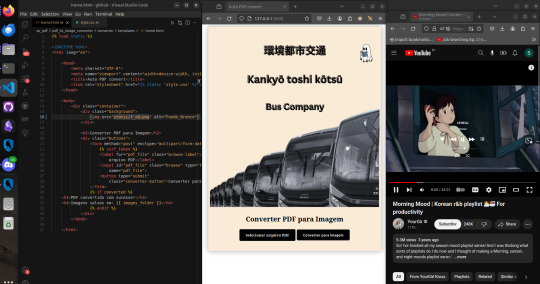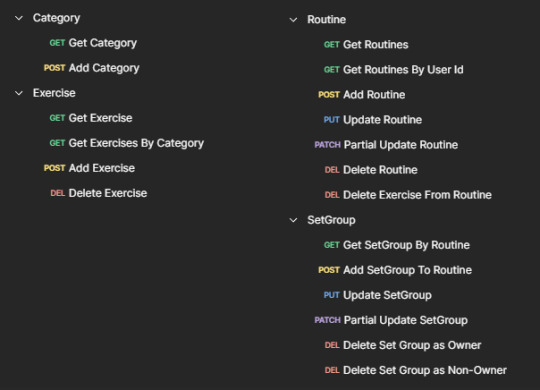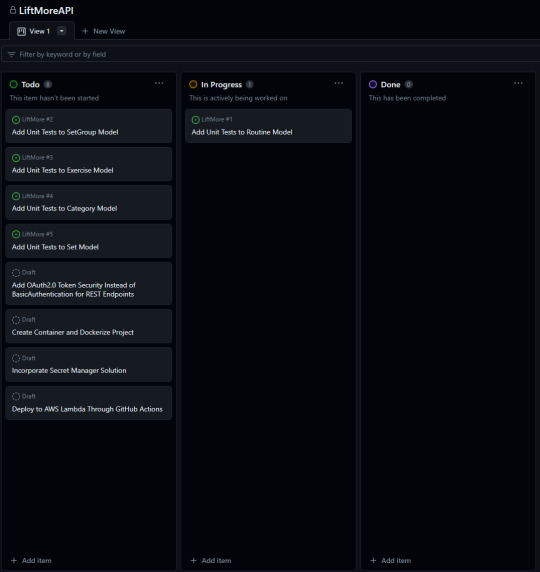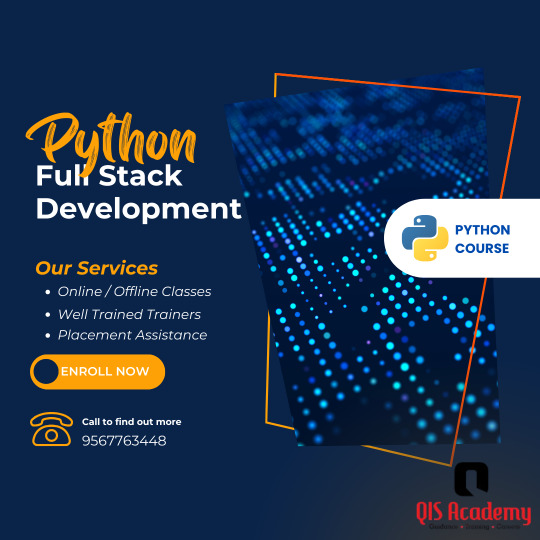#Python Django development
Explore tagged Tumblr posts
Text
Django power house supports the most popular relational database management systems like MySQL, Oracle etc. To Know More @ https://bit.ly/3pMJU2U
0 notes
Text

This one has an interesting story. It was in a place where we shared files through a shared data server locally (localhost only), so there was no network access to use the famous "I love PDF" or software like Adobe to convert and make some changes.
With that in mind, I used the PyPDF library to make a code that changes like converting, splitting, merging, and set it up on the server for people to use. Everyone loved both how the program worked and the crazy aesthetic that I made it and my boss approved. Well, problem solved! And fun too, I must say. And since this is a Studyblr, I have to mention how worthwhile it is to study a library you've never seen before but that seems to do everything you need at that moment. Putting a small project into practice, seeing how people react to it, then studying and improving it in a way that reflects your own growth. That was made with Django Web Framework.
#dark academia#dark art#dark aesthetic#study#study blog#studying#study motivation#study aesthetic#coding#python#django#programming#student life#programmer#software development#software#softwarengineer#softwareengineering#computerscience#studentlife#student#studyblr#studyblr community#screenshot#brazil#brasil
11 notes
·
View notes
Text
Deploying Django Applications to Heroku
Learn how to deploy your Django applications to Heroku with this comprehensive guide. Follow step-by-step instructions to set up, configure, and deploy your app seamlessly.
Introduction Deploying Django applications to Heroku is a streamlined process thanks to Heroku’s powerful platform-as-a-service (PaaS) offerings. Heroku abstracts away much of the infrastructure management, allowing developers to focus on building and deploying their applications. This guide will walk you through the steps to deploy a Django application to Heroku, including setting up the…

View On WordPress
5 notes
·
View notes
Text
LiftMore Update 9.04.2023
I was posting updates on my Medium (see the pinned post), but lately I haven't had time to make a thorough post. Instead, I want to update on a few things in a more informal post here.
API Updates

Finally went through and added all of the endpoints I'll need. There are a few endpoints on this list that I'm still in the process of refining permissions and making more secure.
Unit Testing ...ayup.. I came this far into the project without writing a single unit test. I really do want to strive for best TDD practices, but when there's no code at all in my application, it feels really unsatisfying to start working on tests before my code is capable of doing anything. Moving forward in the project, I will definitely strive to do TDD well.
Security Currently, the API just processes users via Basic Authentication. In this upcoming week, I'm planning on creating an identity server and using that server to issue my own OAuth2.0 tokens. I'm not sure yet how I want to set up my IDP service and OIDC Identity Providers.
Deployments Before moving onto the Front-End for this project, I want to make sure that my app is as secure and robust as possible. For this, I want to create 3 different environments (Development, Test, and Production), use a secret manager to inject secrets into the application, and have all of my deployments automated with GitHub Actions. In addition to all this, I want to make sure my application is set up properly between GitHub Actions and AWS so that I can manage dashboards and collect usage/cost information before having any users.
Finally, I'm happy to say that I've acquired the domain name "liftmore.app". After I get through some of the things I mentioned here, I'll push out a landing page and more information of LiftMore from a user perspective in case anybody wants to use it :)
Lastly, little brief preview of my Project board in GitHub at the moment.

8 notes
·
View notes
Text

📣 New Python Batch Alert!
🔗 Register here: https://tr.ee/Chl7PS
🧠 Learn: Python, Django, HTML, JS, Bootstrap, Angular, Database
🗓️ Start Date: April 9th, 2025 🕢 Time: 7:30 AM IST 👨🏫 Trainer: Mr. Mahesh 💻 Mode: Classroom & Online
📍 KPHB (Beside Metro Station) 🌐 Webex ID: 2513 181 6287 | Pass: 112233
. #PythonTraining #FullStackDeveloper #CodingBootcamp #NareshIT #DevJourney
https://tr.ee/Chl7PS
#python training#full stack developer#Coding Bootcamp#django#development#course#training#angular#bootstrap#java#coding#software developers#programming#software engineering#python#data science#data scientist
0 notes
Text
The Ultimate Guide to Python AI Backend Website Performance Improvement with Shine Infosoft

"Performance is not just about speed; it's about efficiency, scalability, and reliability." – This statement holds especially true in the world of AI-powered applications. In today’s fast-paced digital landscape, slow response times, inefficient processing, and performance bottlenecks can significantly hinder user experience and business growth.
Many businesses leverage Python-based AI backends to power intelligent applications, but performance issues often arise due to slow API response times, unoptimized machine learning model inference, excessive memory consumption, and inefficient database queries. These challenges not only affect website speed but also impact user engagement, operational costs, and scalability.
What if your Python AI backend could deliver lightning-fast responses, seamless AI-powered interactions, and optimized resource utilization? By implementing cutting-edge performance optimization strategies, businesses can significantly enhance the efficiency of their AI-driven applications.
At Shine Infosoft, we specialize in Python AI backend optimization, helping businesses improve website speed, scalability, and overall performance. Whether it’s optimizing AI model inference, streamlining database queries, implementing caching strategies, or leveraging cloud-based scalability solutions, our expert team ensures that your AI-driven web applications run at peak efficiency.
In this blog, we’ll explore why performance optimization is crucial for AI-powered websites, common bottlenecks in Python backends, and advanced strategies to enhance AI processing speed and efficiency. Let’s dive in! 🚀
Why Website Performance Matters for AI-Driven Applications
A high-performing Python AI backend ensures faster processing, improved user engagement, and cost-effective operations. Here’s why it’s essential:
Better User Experience & Engagement
AI-powered applications rely on real-time processing; delays frustrate users.
Faster responses lead to improved customer retention and satisfaction.
Quick AI model inference enhances interactive user experiences in chatbots, recommendation systems, and predictive analytics.
Higher SEO & Search Engine Rankings
Search engines prioritize faster websites in their rankings.
Optimized backend APIs ensure quicker content delivery and better indexing.
Speed improvements lead to higher page dwell time and lower bounce rates.
Reduced Operational Costs & Resource Utilization
Efficient backend architecture reduces server resource consumption.
Optimized AI processing minimizes unnecessary computing expenses.
Reduced cloud service costs due to better memory and CPU management.
Scalability & Business Growth
A well-optimized AI backend supports increased user traffic.
Enhanced efficiency allows seamless scaling without performance degradation.
Supports business expansion by maintaining fast and reliable AI-driven experiences.
Common Performance Bottlenecks in Python AI Backends
Despite Python’s flexibility and extensive AI libraries, certain issues can degrade performance:
Slow API Response Times
Inefficient API endpoints lead to sluggish user interactions.
Blocking I/O operations cause delays in request processing.
Poorly optimized REST and GraphQL APIs add latency to data retrieval.
Unoptimized Database Queries
Poor indexing and redundant queries slow down database retrieval.
Large datasets can overwhelm servers, affecting AI model efficiency.
Improper joins and missing indexes in relational databases create bottlenecks.
High Memory & CPU Utilization
Poorly optimized machine learning models consume excessive resources.
Inefficient looping and recursive functions increase processing time.
Large neural networks without optimization slow down inference speeds.
Lack of Caching Mechanisms
Repeated AI model inference for similar requests slows performance.
No caching leads to unnecessary database queries and computations.
Absence of distributed caching solutions causes redundant API calls.
Inefficient AI Model Inference
Large deep learning models result in slower prediction times.
Lack of hardware acceleration (e.g., GPUs, TPUs) impacts efficiency.
Over-reliance on CPU-based inference leads to suboptimal performance.
Advanced Strategies for Python AI Backend Performance Optimization
To address these challenges, Shine Infosoft employs cutting-edge performance enhancement techniques:
Code Optimization & Efficient Processing
Implement asynchronous programming using Asyncio and FastAPI.
Use optimized data structures and algorithms to reduce computational overhead.
Profile code using cProfile and line_profiler to identify bottlenecks and optimize execution paths.
Database Optimization
Use indexing, partitioning, and query optimization to speed up database access.
Implement caching mechanisms such as Redis or Memcached to reduce repeated queries.
Optimize Object-Relational Mappers (ORMs) like SQLAlchemy and Django ORM for better performance.
AI Model Optimization
Apply model quantization and pruning to reduce model size and improve inference speed.
Use TensorRT or ONNX to optimize deep learning models for faster execution.
Implement batch processing and model parallelization for handling multiple requests efficiently.
Load Balancing & Scalability
Utilize microservices architecture to distribute processing workloads.
Deploy applications using Docker and Kubernetes for scalable deployment.
Implement message queues like RabbitMQ or Kafka to manage background tasks efficiently.
Hardware Acceleration & Parallel Computing
Utilize GPUs and TPUs to accelerate AI model inference.
Implement parallel processing frameworks like Dask or Ray for large-scale computations.
Offload non-essential computations to background workers.
Conclusion & Call to Action
🚀 At Shine Infosoft, we specialize in optimizing Python AI backends to ensure exceptional speed, scalability, and efficiency. Our expertise helps businesses enhance website performance, AI processing speed, and user engagement.
🔹 Ready to supercharge your Python AI backend? Contact Shine Infosoft today for a free performance audit and consultation! 🚀
Source
#hire python developer#Python Development Agency#hire django developer#hire flask developer#hire fullstack developer
0 notes
Text
Master Web Development with Django: Python Framework for Beginners to Pros
Take your web development skills to the next level with this comprehensive course on Django, the powerful Python framework designed to simplify building modern, feature-rich web applications. Whether you're just starting or looking to advance your existing knowledge, this course equips you with the tools and techniques needed to create robust, scalable, and dynamic websites
0 notes
Text

As a freelance Python developer, I create powerful web applications, APIs, and automation scripts. With expertise in frameworks like Django and Flask, I deliver secure, scalable, and efficient solutions tailored to your business needs. Let's collaborate and turn your ideas into reality with clean, reliable code.
#python developers#django#api development#framework#web application#website design#freelance python developer#flask
0 notes
Text
Top Tools for Web Development in 2025
Web development is an ever-evolving field, requiring developers to stay updated with the latest tools, frameworks, and software. These tools not only enhance productivity but also simplify complex development processes. Whether you’re building a small business website or a complex web application, having the right tools in your toolkit can make all the difference. Here’s a rundown of the top…

View On WordPress
#Angular Framework#API Development Tools#Back-End Development Tools#Best Tools for Web Development 2024#Bootstrap for Responsive Design#Django Python Framework#Docker for Deployment#Front-End Development Tools#GitHub for Developers#Laravel PHP Framework#Modern Web Development Tools#Node.js Back-End Framework#Popular Web Development Software#React Development#Tailwind CSS#Testing and Debugging Tools#Vue.js for Web Development#Web Development Frameworks
0 notes
Text
#Backend Developers#Backend Development#Hire Django Developers#Reasons Django with Python#Python App Development#Python Web Development#Django app Development#django development#Mobile App Development Company#Web Development Company#Enterprise Development Company
0 notes
Photo







Visit my website to see my private photos (via @daisy's profile - Lotte Harper)
#website#webdesign#logodesign#python#webdev#https#django#javascript#programming#psf#python software development services#onlinebusiness#onlinestore#onlineshopping#paymentprocessing#cryptopayments#portrait
0 notes
Text

Join the full stack developer course in kochi for hands-on Python skills. From HTML to Django, learn everything needed for tech success. https://www.qisacademy.com/course/python-full-stack-development
#python full stack course training in kochi#full stack developer course in kochi#Python – Django Fullstack Training and Internship Calicut#Best Python Training in Kochi & Calicut#Best python training course kochi#python training course kochi#Python full stack development training in Kochi
0 notes
Text

How to Install and Use a Package in Django Framework.
Cómo Instalar y Usar un Paquete en Django Framework.
👉 https://blog.nubecolectiva.com/como-instalar-y-usar-un-paquete-en-django-framework/
#djangoframework#python#web development#devs#developers#backendevelopment#software#pip#framework django#comunidaddeprogramadores#100daysofcode#developerlife#worldcode
0 notes
Text
youtube
🗣️💻 Our experts break down the differences between #Django and #Laravel, sharing real-life examples from projects we've delivered to our clients. Whether you're building a complex enterprise CMS, a real-time trading platform, or a SaaS app, choosing the right tech stack is crucial! 😉 ⬇️��� Watch now to see which #framework comes out on top for different scenarios, and get insights on the best use cases for both Django and Laravel.Свернуть
0 notes
Text
Exploring Django with Zoople Technologies: Your Gateway to Python Mastery in Kochi

Django is a high-level web framework designed for rapid development and clean, pragmatic design. Its robust features and ease of use have made it a favorite among developers looking to build dynamic web applications. In this blog, we’ll explore what makes Django unique and how Zoople Technologies can help you master it with comprehensive Python training in Kochi.
What is Django?

Django is an open-source web framework written in Python, created in the early 2000s and released to the public in 2005. The framework promotes the use of the Model-View-Template (MVT) architecture, separating data handling, business logic, and user interface components. This structure streamlines development, enhancing code organization and making applications easier to maintain and scale.
Key Features of Django
1. Rapid Development

Django’s design philosophy emphasizes speed and efficiency. Its “batteries-included” approach means it comes with built-in features, such as an authentication system, an admin interface, and form handling. This allows developers to focus on writing application-specific code rather than reinventing the wheel.
2. Robust Security

Security is a primary concern in web development, and Django addresses it head-on. The framework includes numerous security features to protect against common vulnerabilities like SQL injection, cross-site scripting (XSS), and cross-site request forgery (CSRF). This built-in security helps developers create safer applications with minimal effort.
3. Scalability

Django is designed to handle large-scale applications. Its capability to manage high levels of traffic and data makes it suitable for websites with fluctuating user loads, such as e-commerce sites and social media platforms. As your application grows, Django can scale with it, ensuring consistent performance.
4. Versatile Framework

Django’s versatility allows developers to build a wide range of applications—from simple blogs and personal websites to complex enterprise-level systems. Its flexibility extends to integration with various databases and technologies, making it adaptable to different project requirements.
5. Strong Community Support

Django boasts a vibrant community of developers who continually enhance the framework. This active community ensures that Django remains up-to-date with the latest technologies and best practices. Developers can access extensive documentation, tutorials, and forums, making it easier to find support and resources.
Learning Django with Zoople Technologies
At Zoople Technologies, we understand that mastering Django requires more than just theoretical knowledge. Our Python training in Kochi offers hands-on experience, allowing you to build real-world applications using Django. Our expert instructors guide you through the entire process, from setting up your environment to deploying your applications.
Benefits of Training at Zoople Technologies
Comprehensive Curriculum: Our training program covers all aspects of Django, ensuring you gain a solid understanding of its features and capabilities.
Practical Experience: You’ll work on real projects, applying your skills in a practical context to prepare you for the job market.
Expert Guidance: Learn from industry professionals who bring their real-world experience to the classroom, providing insights that go beyond textbooks.
Networking Opportunities: Connect with fellow learners and industry professionals, expanding your professional network.
Best Practices for Django Development
To maximize your learning experience, consider these best practices:
Use Virtual Environments: Isolate your project dependencies to avoid conflicts and ensure a clean development environment.
Leverage Django Packages: Utilize third-party packages available in the Django ecosystem to enhance functionality without reinventing the wheel.
Write Tests: Implement testing early in your development process to ensure the reliability and stability of your application.
Follow the DRY Principle: Django promotes the "Don't Repeat Yourself" principle, encouraging code reuse to enhance maintainability.
Conclusion
Django is more than just a web framework; it’s a powerful tool that can significantly speed up the development process while ensuring security and scalability. Its rich feature set, strong community, and commitment to best practices make it an ideal choice for developers of all skill levels.
With the right training from Zoople Technologies, you can become proficient in Django and unlock your web development potential. Whether you are looking to build a personal project or aiming for a career in tech, our Python training in Kochi will equip you with the skills you need to succeed. Dive into Django with us and start your journey toward mastering one of the most popular frameworks in the world!
#python development company#django#python training#datascience#python software development services#ai#ai generated
1 note
·
View note